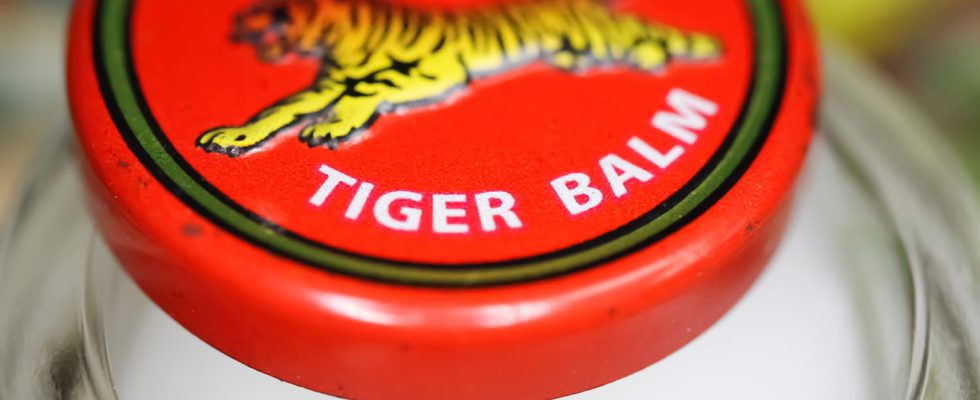This traditional Asian balm can relieve many small health problems. It can be used both in massage and in inhalation. What’s in it? What are its benefits ? What are its contraindications? Explanations from Sylvie Hampikian, pharmacologist.
What is White Tiger Balm?
Tiger Balm is a ointment, developed in the 19th century by a Chinese herbalist to treat many everyday ailments. There are two versions of the balm: red and white. “Tiger Balm, whether red or white, shares a common ingredient base but in different amounts, such as camphor and menthol essential oilto which are then added distinct components, which ensures their benefits and indications of their ownexplains Sylvie Hampikian, pharmacologist. Thus, the White Tiger Balm contains 25% camphor, 8% menthol, 1.5% clove essential oil and 14% eucalyptus essential oil“. It has a cooling effect.
What are the differences with the Red Tiger Balm?
The recipe for Red Tiger Balm, although very close, differs a little from that of White Tiger Balm. “Red Tiger Balm contains 25% camphor, 10% menthol, 5% clove essential oil, 7% cajeput essential oil, 6% mint essential oil and 5% Chinese cinnamon essential oil“, specifies Sylvie Hampikian. With this composition, Red Tiger Balm has a warming effect and is more readily used to treat muscle pain (cramps, aches, etc.), joint pain (osteoarthritis, rheumatism, sprain…), tendonitis, back pain… It can also be used to warm up the muscles before a sporting effort or after, to promote recovery.
What are the benefits of White Tiger Balm?
Due to its composition, White Tiger Balm has many benefits:
- He relieves motion sickness
- He overcomes the nausea and digestive problems
- He calms the insect bites and irritations due to stinging plants
- It relieves the feelings of heavy legs
- He soothes the sunburn and burns
- He treats the ENT sphere
Does it have benefits for the common cold?
“Yes, thanks to its eucalyptus essential oil content, White Tiger Balm is effective in decongesting the nose and improve breathing, assures the pharmacologist. It’s a ally in case of colds or sinusitis.
Does it have benefits for sore throat?
“Due to the presence of camphor, the white tiger balm can help soothe sore throatsin external massage along the neck“, recommends our expert.
Does it have benefits for headache and migraine?
The cooling effect caused by menthol, camphor and eucalyptus essential oil act in synergy to calm the twinges of headaches and migraines. To be used from the first pains.
Does it have benefits for back pain?
It is an indication that comes back more with red Tiger Balm which, through its heating actions, manages to relieve muscle pain.
Does it have benefits for tendonitis?
“If, in massage, the White Tiger Balm can bring you relief, it is an indication that corresponds more to the Red Tiger Balm“, notes Sylvie Hampikian.
It is not recommended for pregnant and breastfeeding women, children under 10 and epileptics.
► In case of common coldWhite Tiger Balm should be applied at nose level (unless the skin is irritated due to frequent blowing) or inhaled. “Simply melt a knob of product in a bowl of very hot water and breathe in the scent 10-15 minutes to clear airways“, advises Sylvie Hampikian.
► To calm down headache or migraine, Tiger Balm can be applied to the forehead and temples, away from the eyes. Proceed to a gentle circular massage.
► To process a sore throatthe balm can be applied in gentle massage directly on the throat and up to the level of the bronchi that it can help clear.
► Finally, to overcome a stinga feeling of burnof pain in the legs due to a circulatory disorder, Tiger Balm is used in massage on the painful area until complete absorption of the product.
What contraindications and precautions for use?
Due to the high content of essential oils, including potentially neurotoxic camphor, Tiger Balm is not recommended for pregnant and breastfeeding women, at the children under 10 years oldas well as in people with epilepsy. Finally, avoid contact with the eyes and wash your hands after use.
Thanks to Sylvie Hampikian, pharmacologist.
